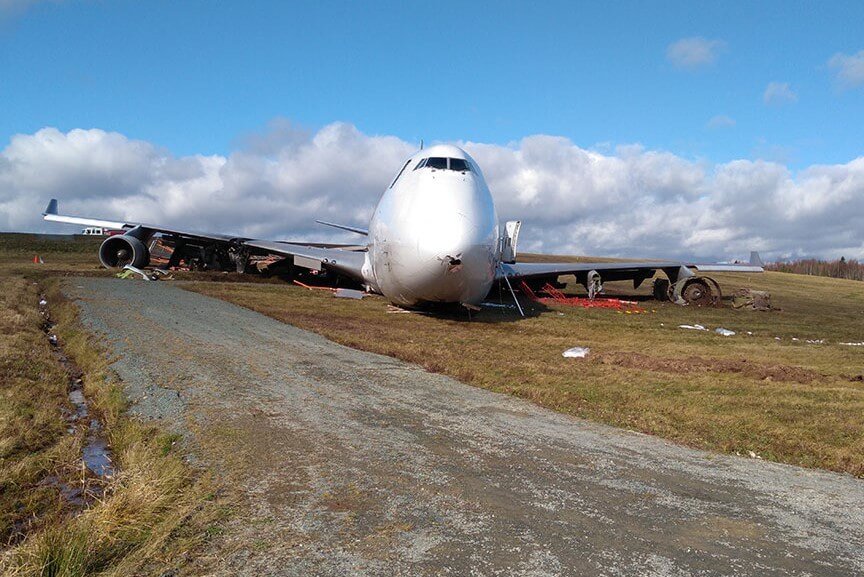The Transportation Safety Board of Canada found out that confusing NOTAM, an unexpected tailwind, and crew fatigue all contributed to Sky Lease Cargo 747 runway overshoot in Halifax in 2018.
On November 7, 2018, the Sky Lease Cargo Boeing 747-412F aircraft, registration N908AR, was conducting flight 4854 from Chicago-O’Hare International Airport, United States, to Halifax-Stanfield International Airport, Canada, with 3 crew members, 1 passenger, and no cargo on board.
Upon landing, the aircraft overshot the runway by 270 metes (885 feet). All three crew members received minor injuries and were taken to the hospital. The passenger was uninjured.
In its final report published on June 29, 2021, the Transportation Safety Board of Canada identified multiple causes that contributed to the incident.
While preparing the flight, the crew consulted the NOTAMs that concerned Halifax. While in normal conditions, they would have used runway 23 which was 10,500 feet (3,200 meters) long. A NOTAM indicated that the first 1,767 feet (538 meters) of runway 23 were unavailable due to light and marking renovation work. While 8,733 feet (2,661 meters) of the runway were still available, and largely sufficient, the use of the wording “NOT AUTH” on the NOTAM led the crew to believe they could not land on the nominal runway. Thus, the crew expected to land on runway 14, which is 7700 feet (2347 m) long.
As the flight was approaching the airport at around 5 am local time, air traffic control did not report to the crew that runway 23 was available, although an automated information system was broadcasting that information, though it was reported on the automatic terminal information service (ATIS).
One minute and 21 seconds ahead of reaching the final approach threshold, the tower controller informed the pilots that there was a constant tailwind component of 7 knots on runway 14. The flight crew did not have time to recalculate the required landing distance and assess the options available to them.
After touching down, the engine No. 1 thrust lever was moved forward of the idle position for undetermined reasons, causing the speed brakes to retract, and the autobrake system to disengage, increasing the landing distance required.
“In addition, the drift angle to the right (4.5 °) at the initial touchdown point, combined with the crosswind component and the asymmetric selection of the reversers, caused the aircraft to deviate to the right of the runway axis,” investigators explained.
Manual brake was applied 8 seconds after the touchdown point, but maximum braking force did not occur until 15 seconds later, when the aircraft was 800 feet from the end of the track. “From this location, it was not possible to stop the aircraft on the runway and, 5 seconds later, the aircraft left the end of the runway at a speed of 77 knots,” states the report.
The Boeing 747 passed the runway end and fell down an embankment, hitting the approach light pillars and the runway alignment antenna array. It came to a stop 270 m (885 feet) past the end of the runway. Engine #2 detached from the pylon and struck the left horizontal stabilizer, creating a fire in the tail.
All occupants managed to deplane by themselves and were taken for medical care. Firefighting personnel responded to control the fire. The aircraft was damaged beyond repair.
The investigation found that the timing of the flight lack of restful sleep during the 24-hour period leading up to the occurrence might have contributed to the fatigue of the crew and affected their performance.

